INSTITUT SUPERIEUR D'ANTHROPOLOGIE
INSTITUT OF ANTHROPOLOGY
COURS ONLINE – COURS A DISTANCE
INSCRIPTIONS : SEPTEMBRE 2023
REGISTER NOW
ALLEMAGNE – 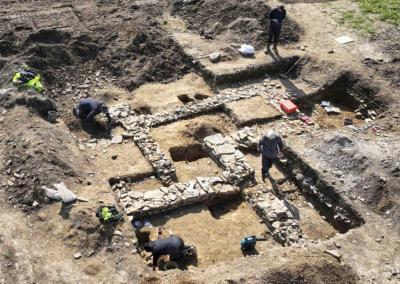
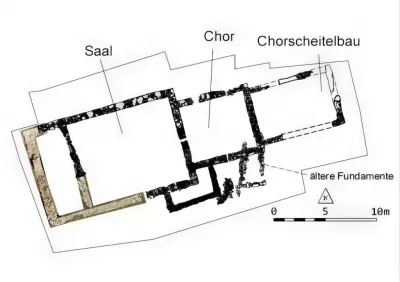 Erwitte - Archaeologists from the Westphalia-Lippe Regional Association (LWL) have discovered the remains of a former church from the 10th century near Erwitte-Eikeloh (Soest district). The 30-meter-long stone building has a floor plan that was previously unknown in Westphalia, northwestern Germany. In 2021, a volunteer drew the LWL experts’ attention to a concentration of limestone fragments in a stream meadow east of Erwitte. In the same year, an inspection of the structure, which would have been threatened with destruction by the plow at some point, surprisingly revealed the foundations of a stone building. After further excavations in 2022 and 2023, it is clear: these are the last remains of a church with a floor plan that is unique in Westphalia. he finding is particularly unexpected because written sources for a church are completely missing. The earliest reports that refer to a settlement around the Bachaue come from the 11th century. However, these only mention the hamlet of “Osthem”, but no church. “We were able to prove that the church was rebuilt here after a much older farmstead was demolished,” reports excavation manager Dr. Eva Cichy from the Olpe branch of LWL Archaeology. “We have excavations of post buildings around the church and below the foundations, which indicate settlement at this location since the Roman Empire,” Cichy continued. “In order to classify and date the church building more closely, we rely not only on meaningful finds but also on scientific results,” explains the head of the Olpe branch, Prof. Dr. Michael Baales. Ceramic finds, the first 14C dating and comparisons with other floor plans currently indicate that the building dates back to around 900 AD. An entirely unrecorded floor plan of this period is not unusual in Westphalia. New churches were usually built on top of their predecessors. For this reason, the older floor plans are often largely destroyed or can only be seen in parts during excavations. The floor plan in Eikeloh is much more complex and does not correspond to the usual pattern of hall and choir. The newly discovered church consists of an 8.40-meter vast hall, to which a rectangular choir adjoins to the east. An additional room to the east of the choir, a so-called choir apex building, is unusual. This room could have been planned as a chapel or burial place. “Such a floor plan is so far unique in Westphalia, but comparable church buildings are known, for example from the collegiate churches in Bonn-Vilich and the Niedermünster in Regensburg,” reports LWL chief archaeologist Prof. Dr. Michael Rind. The church in Eikeloh was probably completed, as remains of plaster and a later additional extension in the south suggest. However, it was probably abandoned after a short time and planned to be demolished before the 12th century. Why is one of the mysteries that the archaeologists want to get to the bottom of as part of the evaluation of the excavation results over the next few years?
Erwitte - Archaeologists from the Westphalia-Lippe Regional Association (LWL) have discovered the remains of a former church from the 10th century near Erwitte-Eikeloh (Soest district). The 30-meter-long stone building has a floor plan that was previously unknown in Westphalia, northwestern Germany. In 2021, a volunteer drew the LWL experts’ attention to a concentration of limestone fragments in a stream meadow east of Erwitte. In the same year, an inspection of the structure, which would have been threatened with destruction by the plow at some point, surprisingly revealed the foundations of a stone building. After further excavations in 2022 and 2023, it is clear: these are the last remains of a church with a floor plan that is unique in Westphalia. he finding is particularly unexpected because written sources for a church are completely missing. The earliest reports that refer to a settlement around the Bachaue come from the 11th century. However, these only mention the hamlet of “Osthem”, but no church. “We were able to prove that the church was rebuilt here after a much older farmstead was demolished,” reports excavation manager Dr. Eva Cichy from the Olpe branch of LWL Archaeology. “We have excavations of post buildings around the church and below the foundations, which indicate settlement at this location since the Roman Empire,” Cichy continued. “In order to classify and date the church building more closely, we rely not only on meaningful finds but also on scientific results,” explains the head of the Olpe branch, Prof. Dr. Michael Baales. Ceramic finds, the first 14C dating and comparisons with other floor plans currently indicate that the building dates back to around 900 AD. An entirely unrecorded floor plan of this period is not unusual in Westphalia. New churches were usually built on top of their predecessors. For this reason, the older floor plans are often largely destroyed or can only be seen in parts during excavations. The floor plan in Eikeloh is much more complex and does not correspond to the usual pattern of hall and choir. The newly discovered church consists of an 8.40-meter vast hall, to which a rectangular choir adjoins to the east. An additional room to the east of the choir, a so-called choir apex building, is unusual. This room could have been planned as a chapel or burial place. “Such a floor plan is so far unique in Westphalia, but comparable church buildings are known, for example from the collegiate churches in Bonn-Vilich and the Niedermünster in Regensburg,” reports LWL chief archaeologist Prof. Dr. Michael Rind. The church in Eikeloh was probably completed, as remains of plaster and a later additional extension in the south suggest. However, it was probably abandoned after a short time and planned to be demolished before the 12th century. Why is one of the mysteries that the archaeologists want to get to the bottom of as part of the evaluation of the excavation results over the next few years?
An unknown church with a special floor plan discovered in Erwitte, northwestern Germany - Arkeonews
ECOSSE – 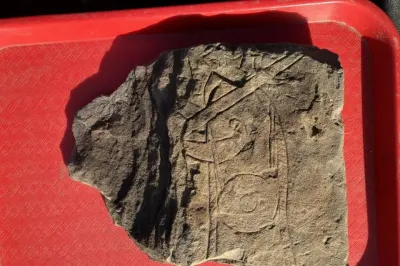 Glasgow - An archaeological dig within the churchyard at Govan Old Parish Church in Glasgow has uncovered a "remarkable" early medieval 'Govan Warrior' stone. The early medieval carved stone is "quite unlike" any others discovered at the ancient site - which is celebrated for the richness of its Viking-age sculpture. The stone portrays a man side-on carrying a round shield and a shaft over their shoulder. The man is probably carrying either a sword or a spear and can be described as a warrior. While much of the warrior’s face has been damaged since it was carved over a thousand years ago, remarkable details suggest a flowing pony-tail and a sharply pointed beard. The oldest known Christian site in Glasgow, Govan Old was built in 1888 and stands on a religious site dating back to the sixth century. The Govan Warrior is lightly incised, which may bring parallels with famous Pictish stones like the Rhynie Man from Aberdeenshire.
Glasgow - An archaeological dig within the churchyard at Govan Old Parish Church in Glasgow has uncovered a "remarkable" early medieval 'Govan Warrior' stone. The early medieval carved stone is "quite unlike" any others discovered at the ancient site - which is celebrated for the richness of its Viking-age sculpture. The stone portrays a man side-on carrying a round shield and a shaft over their shoulder. The man is probably carrying either a sword or a spear and can be described as a warrior. While much of the warrior’s face has been damaged since it was carved over a thousand years ago, remarkable details suggest a flowing pony-tail and a sharply pointed beard. The oldest known Christian site in Glasgow, Govan Old was built in 1888 and stands on a religious site dating back to the sixth century. The Govan Warrior is lightly incised, which may bring parallels with famous Pictish stones like the Rhynie Man from Aberdeenshire.
'Remarkable': Early medieval 'Govan Warrior' stone discovered during church fun day (yahoo.com)
FRANCE – 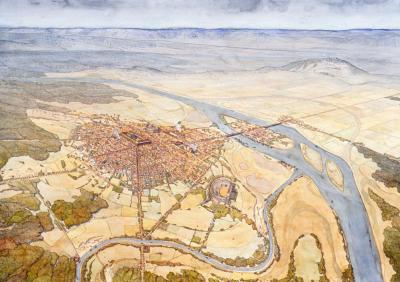 Paris – A partir du Ier siècle après J.-C., Lutèce se développe sur la rive gauche de la Seine. Ses quartiers sont structurés par un réseau de voies orthogonales et reliés par le cardo maximus (principale voie nord-sud dans les villes gallo-romaines), au niveau de l'actuelle rue Saint-Jacques. Le forum, flanqué de ses thermes, constitue l’élément central de la ville, qui compte aussi un théâtre et d’autres thermes, à savoir ceux du Collège de France et de Cluny. La fouille en cours se situe aux marges de la cité du Haut Empire (Ier-IIIe siècles). La fouille a mis au jour plusieurs phases d’occupation. Elles sont représentées par des successions de sols, des tranchées de récupération des fondations en pierre de constructions antiques, une aire de circulation présentant de multiples recharges, une vaste fosse (citerne ou réceptacle d’eau pour des activités artisanales ?), transformée en dépotoir et un secteur qui peut être interprété comme une forge. Le secteur interprété comme une forge comprend un four, des structures renfermant de nombreux débris métalliques (battitures et scories) propres à la métallurgie de plein air, et une aire de travail aménagée. L’analyse des scories et battitures présentes dans les sédiments permettra de mieux cerner quelle partie du processus du travail métallurgique est attestée sur le site. La découverte de vestiges domestiques (vaisselle de table en céramique), d’éléments de parure (fibule en bronze), d’objets de la vie quotidienne (spatule en bronze, figurine d’une divinité en terre cuite), d’éléments de décor architectural (enduits peints, tesselles de mosaïque en pierre ou céramique) confirme la proximité immédiate d’un habitat, décelé lors de fouilles réalisées en 1989.
Paris – A partir du Ier siècle après J.-C., Lutèce se développe sur la rive gauche de la Seine. Ses quartiers sont structurés par un réseau de voies orthogonales et reliés par le cardo maximus (principale voie nord-sud dans les villes gallo-romaines), au niveau de l'actuelle rue Saint-Jacques. Le forum, flanqué de ses thermes, constitue l’élément central de la ville, qui compte aussi un théâtre et d’autres thermes, à savoir ceux du Collège de France et de Cluny. La fouille en cours se situe aux marges de la cité du Haut Empire (Ier-IIIe siècles). La fouille a mis au jour plusieurs phases d’occupation. Elles sont représentées par des successions de sols, des tranchées de récupération des fondations en pierre de constructions antiques, une aire de circulation présentant de multiples recharges, une vaste fosse (citerne ou réceptacle d’eau pour des activités artisanales ?), transformée en dépotoir et un secteur qui peut être interprété comme une forge. Le secteur interprété comme une forge comprend un four, des structures renfermant de nombreux débris métalliques (battitures et scories) propres à la métallurgie de plein air, et une aire de travail aménagée. L’analyse des scories et battitures présentes dans les sédiments permettra de mieux cerner quelle partie du processus du travail métallurgique est attestée sur le site. La découverte de vestiges domestiques (vaisselle de table en céramique), d’éléments de parure (fibule en bronze), d’objets de la vie quotidienne (spatule en bronze, figurine d’une divinité en terre cuite), d’éléments de décor architectural (enduits peints, tesselles de mosaïque en pierre ou céramique) confirme la proximité immédiate d’un habitat, décelé lors de fouilles réalisées en 1989.
Actualité | Une occupation antique à l’École des Mines de Paris | Inrap
TURQUIE - Savatra - Archaeologists have unearthed a mass grave of children dating back to the fifth century in the ancient city of Savatra in the Central Anatolian province of Konya. During surface surveys in 2020, a remarkable discovery was made — an inscription in the Greek alphabet bearing the word “Türkoğlu,” the descendant of a Turk in Turkish, marking the first occurrence of the term “Turk” in Anatolia. This year's excavation efforts led to the discovery of mosaic floors in a 400-square-meter area, presumably belonging to a church foundation. As the excavation continued, a collective children's burial site dating to the fifth century was revealed. "We encountered two different burial typologies in terms of east-west orientation, consisting of chamber tombs and tile graves. We identified a children's cemetery, primarily consisting of non-adult individuals, ranging from fetuses to approximately 13-14 years of age. In total, we found 42 skeletons here," Işık explained. Highlighting the distinct burial techniques found, Işık added, "For example, we encountered instances of stacked burials, even finding five skulls in a single grave. Whether due to familial connections or the functional continuity of the burial sites, we observed these overlapping burials." Various small artifacts, such as coins, rings, and earrings, were also discovered during the excavation. Starting this year, excavation efforts are continuing in the area known as the narthex, situated at the rear of the church. Significant discoveries have already been made in this approximately 400-square-meter mosaic area. “This is indeed a crucial find for Anatolia. The presence of such a splendid mosaic area in Konya not only underscores the richness and grandeur of the region but also serves as a significant testament to the city's historical importance. In light of this, we intend to persist in our excavation efforts this year, with a particular focus on the mosaic area, to unveil more of its hidden treasures,” Işık said.
Mass grave of children unearthed in ancient city - Türkiye News (hurriyetdailynews.com)
ANGLETERRE – 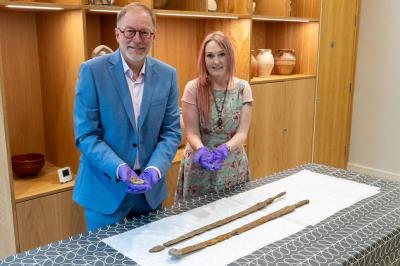 Cotswold - A rare and important find has been unearthed in the Cotswold District. Two Roman cavalry swords along with remnants of their wooden scabbards and fitments were discovered by Glenn Manning during a metal detectorist rally in the north of the Cotswolds. There was also a broken copper alloy bowl discovered with the weaponry. The swords were appraised by Professor Simon James from Leicester University who says that these weapons are middle imperial Roman swords commonly referred to as a spatha. They were in use in the Roman world probably by the 160s, through the later second century and far into the third century AD. Their considerable length suggests that they are cavalry weapons-- or, more accurately, weapons intended for use on horseback. It was not illegal for civilians to own such weapons and to carry them for travelling because Roman provinces were plagued with banditry.
Cotswold - A rare and important find has been unearthed in the Cotswold District. Two Roman cavalry swords along with remnants of their wooden scabbards and fitments were discovered by Glenn Manning during a metal detectorist rally in the north of the Cotswolds. There was also a broken copper alloy bowl discovered with the weaponry. The swords were appraised by Professor Simon James from Leicester University who says that these weapons are middle imperial Roman swords commonly referred to as a spatha. They were in use in the Roman world probably by the 160s, through the later second century and far into the third century AD. Their considerable length suggests that they are cavalry weapons-- or, more accurately, weapons intended for use on horseback. It was not illegal for civilians to own such weapons and to carry them for travelling because Roman provinces were plagued with banditry.
Ancient Roman Swords Unearthed in the Cotswolds “A Remarkable Archaeological Find”
PEROU – 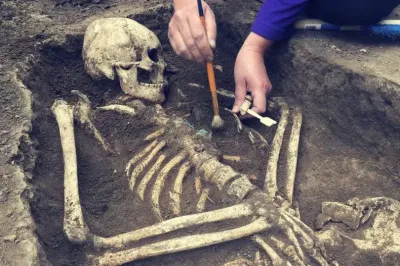 Pallawcha Pampa - Archaeologists have discovered a set of seven ancient tombs belonging to a group of elite individuals in Peru. A team from National University of San Cristóbal de Huamanga (UNSCH) found the tombs at the Pallawcha Pampa archaeological site, which is located high up in the Peruvian Andes mountains in the province of Vilcas Huamán in the Ayacucho region, the Andina news agency reported. Researchers said the tombs, which contain human remains, are likely around 2,900 years old—dating back to before the Wari, or Huari, culture. The Wari had a pre-Hispanic civilization that flourished in the south-central Andes and coastal areas of what is now Peru between roughly A.D. 500 and 1000 This civilization, which predates the Inca Empire, was the most important pre-Hispanic culture in the territory that makes up the modern Ayacucho region. Edison Mendoza Martínez, the head of the UNSCH archaeological team, said the burials discovered at Pallawcha Pampa were the tombs of important figures, calling them "the Lords of Vilcas Huamán." Archaeologists found three mounds at the site's surface level that were surrounded by terraces supported by large stone walls. The team also documented a large quantity of fragmented ceramics scattered around. One of the mounds, known as Central Two, was particularly noteworthy, given that it contained the largest number of archaeological remains.Excavations at this mound uncovered a circular structure and, beneath that, several holes covered by slabs. "When excavating the holes, secondary burials were found—in some cases they were not only of a single individual but of several. As an offering, associated elements were found such as vessels," Mendoza Martínez told the Andina Agency During the excavations at the site, the team documented a group of funerary artifacts, including metal needles, rings and gold feathers. These objects indicate that the burials belonged to an elite group, the researchers said. Mendoza Martínez said the team also found evidence, including complex architecture, that there was a later occupation of the site by the Wari. The next step for the researchers is to carry out a DNA study to determine whether the people buried at the site were related by blood, as well as to conclusively date the remains.
Pallawcha Pampa - Archaeologists have discovered a set of seven ancient tombs belonging to a group of elite individuals in Peru. A team from National University of San Cristóbal de Huamanga (UNSCH) found the tombs at the Pallawcha Pampa archaeological site, which is located high up in the Peruvian Andes mountains in the province of Vilcas Huamán in the Ayacucho region, the Andina news agency reported. Researchers said the tombs, which contain human remains, are likely around 2,900 years old—dating back to before the Wari, or Huari, culture. The Wari had a pre-Hispanic civilization that flourished in the south-central Andes and coastal areas of what is now Peru between roughly A.D. 500 and 1000 This civilization, which predates the Inca Empire, was the most important pre-Hispanic culture in the territory that makes up the modern Ayacucho region. Edison Mendoza Martínez, the head of the UNSCH archaeological team, said the burials discovered at Pallawcha Pampa were the tombs of important figures, calling them "the Lords of Vilcas Huamán." Archaeologists found three mounds at the site's surface level that were surrounded by terraces supported by large stone walls. The team also documented a large quantity of fragmented ceramics scattered around. One of the mounds, known as Central Two, was particularly noteworthy, given that it contained the largest number of archaeological remains.Excavations at this mound uncovered a circular structure and, beneath that, several holes covered by slabs. "When excavating the holes, secondary burials were found—in some cases they were not only of a single individual but of several. As an offering, associated elements were found such as vessels," Mendoza Martínez told the Andina Agency During the excavations at the site, the team documented a group of funerary artifacts, including metal needles, rings and gold feathers. These objects indicate that the burials belonged to an elite group, the researchers said. Mendoza Martínez said the team also found evidence, including complex architecture, that there was a later occupation of the site by the Wari. The next step for the researchers is to carry out a DNA study to determine whether the people buried at the site were related by blood, as well as to conclusively date the remains.
VIDEO = Hallazgo arqueológico: descubren 7 tumbas de "Los Señores de Vilcas Huamán" - YouTube
Archaeologists Discover Seven Tombs of Elite 'Lords' From 3,000 Years Ago (newsweek.com)
NORVEGE –  Vingrom - Archaeologists have discovered a votive gold hoard during road development works in Vingrom, south of Lillehammer on the shores of Lake Mjøsa Norway. The 5 gold pieces are tiny, about the size of a fingernail. They are flat and thin as paper, often square, and stamped with a motif. Usually, they depict a man and a woman in various types of clothing, jewelry, and hairstyles. The objects were discovered in the remains of a pagan temple, where previous excavations have uncovered thirty similar stamped gold objects in the vicinity over the past three decades. The pagan temple measures around fifteen meters in length. Archaeologists have found five gold foil figures in the last couple of weeks. According to the researchers, the objects date from the Merovingian era sometime between AD 550 to the Viking Age. The latest objects were found beneath the structure in the wall runs and in adjacent postholes, suggesting that they were ritually placed as votive offerings in the form of a sacrifice or a religious act to protect the building before it was constructed. Smaller excavations during the 2000s led to the discovery of 28 gold foil figures, and what is referred to as a temple, a house for pagan religious practices. In Norway, findings of gold foil figures are rare. The 35 from the temple in Vingrom represent the largest collection found in this country.
Vingrom - Archaeologists have discovered a votive gold hoard during road development works in Vingrom, south of Lillehammer on the shores of Lake Mjøsa Norway. The 5 gold pieces are tiny, about the size of a fingernail. They are flat and thin as paper, often square, and stamped with a motif. Usually, they depict a man and a woman in various types of clothing, jewelry, and hairstyles. The objects were discovered in the remains of a pagan temple, where previous excavations have uncovered thirty similar stamped gold objects in the vicinity over the past three decades. The pagan temple measures around fifteen meters in length. Archaeologists have found five gold foil figures in the last couple of weeks. According to the researchers, the objects date from the Merovingian era sometime between AD 550 to the Viking Age. The latest objects were found beneath the structure in the wall runs and in adjacent postholes, suggesting that they were ritually placed as votive offerings in the form of a sacrifice or a religious act to protect the building before it was constructed. Smaller excavations during the 2000s led to the discovery of 28 gold foil figures, and what is referred to as a temple, a house for pagan religious practices. In Norway, findings of gold foil figures are rare. The 35 from the temple in Vingrom represent the largest collection found in this country.
1400-year-old gold foil figures found in pagan temple - Arkeonews
SUISSE – 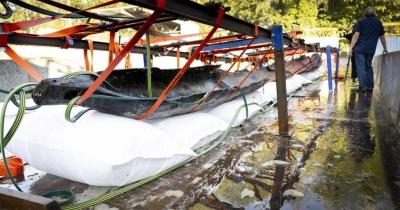 Neuchâtel - An article in The Swiss Reporter said the ancient boat was first spotted in 2021, during an aerial archaeological survey of the lake. Lodged in silt at around 3.5 meters (11.48 ft) deep, radiocarbon dating has determined that the canoe was built between 750 and 520 BC, at which time there were no villages on the lake shores. At a recent press conference, Nicole Pousaz, a cantonal archaeologist, said a team of archaeologists from the Vaud canton's archaeology department used “specialist techniques,” preparing the ancient canoe for salvage. Pousaz added that this is an archaeological discovery “of considerable importance,” as it increases the understanding of prehistory in this region of Switzerland. This discovery represents one of only a few boats dating from this period to have been found in Switzerland. Furthermore, this canoe has been preserved “almost in its entirety," said Pousaz. Now, the canoe is being subjected to analysis by archaeologists, who are using photogrammetry and laser measurements to create a 3D model of the craft, to visualize what it would have looked like when fully operational. Archaeologist Jean-Daniel Renaud told the Keystone-SDA press agency that the canoe was constructed from an oak trunk measuring about 13 meters (42.65 ft) long by about a meter (3.28 ft) in diameter. In her hay-day, this large canoe would have been used for fishing, and for transporting goods and people. However, Renaud said that after around 2,500-years buried in silt, the vessel “is a very sickly old lady.” While this ancient boat is mainly intact, parts of its sides have been lost to storms. Furthermore, the end of the canoe that was buried in the sediment was “badly cracked,” and this is why Renaud called the artifact “a very fragile object [or old lady].” But despite these flaws, Swiss Info reported that the find “is the largest and most well-preserved canoe from this period to be found in the country,” and as such it will be important in providing archaeologists with data pertaining to lifestyles on the lake during the Iron Age.
Neuchâtel - An article in The Swiss Reporter said the ancient boat was first spotted in 2021, during an aerial archaeological survey of the lake. Lodged in silt at around 3.5 meters (11.48 ft) deep, radiocarbon dating has determined that the canoe was built between 750 and 520 BC, at which time there were no villages on the lake shores. At a recent press conference, Nicole Pousaz, a cantonal archaeologist, said a team of archaeologists from the Vaud canton's archaeology department used “specialist techniques,” preparing the ancient canoe for salvage. Pousaz added that this is an archaeological discovery “of considerable importance,” as it increases the understanding of prehistory in this region of Switzerland. This discovery represents one of only a few boats dating from this period to have been found in Switzerland. Furthermore, this canoe has been preserved “almost in its entirety," said Pousaz. Now, the canoe is being subjected to analysis by archaeologists, who are using photogrammetry and laser measurements to create a 3D model of the craft, to visualize what it would have looked like when fully operational. Archaeologist Jean-Daniel Renaud told the Keystone-SDA press agency that the canoe was constructed from an oak trunk measuring about 13 meters (42.65 ft) long by about a meter (3.28 ft) in diameter. In her hay-day, this large canoe would have been used for fishing, and for transporting goods and people. However, Renaud said that after around 2,500-years buried in silt, the vessel “is a very sickly old lady.” While this ancient boat is mainly intact, parts of its sides have been lost to storms. Furthermore, the end of the canoe that was buried in the sediment was “badly cracked,” and this is why Renaud called the artifact “a very fragile object [or old lady].” But despite these flaws, Swiss Info reported that the find “is the largest and most well-preserved canoe from this period to be found in the country,” and as such it will be important in providing archaeologists with data pertaining to lifestyles on the lake during the Iron Age.
Huge and Extremely Ancient Intact Canoe Recovered From Swiss Lake | Ancient Origins (ancient-origins.net)
ISRAEL – 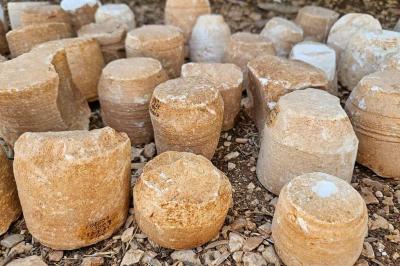 Jerusalem - Israeli archeologists have discovered an ancient workshop for the manufacture of stone utensils just outside Jerusalem, the Civil Administration’s Archaeology Unit announced on Monday. The workshop, which experts said dates back to the Second Temple period (516 BCE-70 C.E.), was discovered along Road 437 between Geva Binyamin/Adam and Kfar Hizma, north of the Israeli capital. “During an excavation administered by the Staff Officer for Archaeology in the Civil Administration, remains were uncovered not only of tools but of an entire production center, which included several quarries,” a spokesperson for the Civil Administration told local media. “During the Second Temple period, it was customary to use utensils made of stone,” added the spokesperson. “Stone utensils have been discovered and are being found at almost every site, in various forms– cups, bowls, trays and various other utensils that are meticulously styled and designed.”
Jerusalem - Israeli archeologists have discovered an ancient workshop for the manufacture of stone utensils just outside Jerusalem, the Civil Administration’s Archaeology Unit announced on Monday. The workshop, which experts said dates back to the Second Temple period (516 BCE-70 C.E.), was discovered along Road 437 between Geva Binyamin/Adam and Kfar Hizma, north of the Israeli capital. “During an excavation administered by the Staff Officer for Archaeology in the Civil Administration, remains were uncovered not only of tools but of an entire production center, which included several quarries,” a spokesperson for the Civil Administration told local media. “During the Second Temple period, it was customary to use utensils made of stone,” added the spokesperson. “Stone utensils have been discovered and are being found at almost every site, in various forms– cups, bowls, trays and various other utensils that are meticulously styled and designed.”
Archeologists uncover ancient stone workshop outside Jerusalem - JNS.org